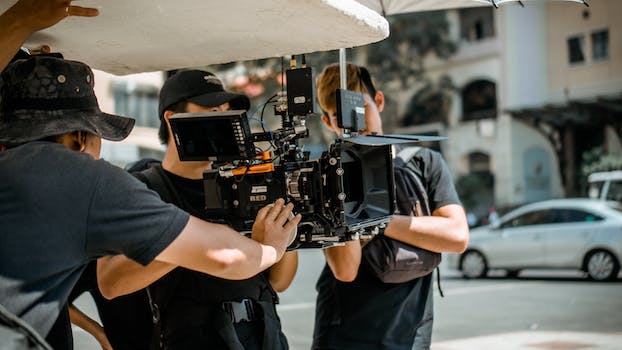Dramatic film critiques are an essential part of the movie industry. They are written to help audiences understand the nuances of a film and appreciate the artistry that goes into making it. A good film critique should be more than just a summary of the plot. It should delve into the themes, characters, and style of the film, and offer insights into what makes it work (or not work). In this article, we will explore the art of writing dramatic film critiques, offering tips and techniques for crafting insightful and engaging reviews.
- 1. Introduction
- 1.1. Defining Dramatic Films
- 1.2. The Importance of Critiquing Dramatic Films
- 1.3. The Role of a Film Critic
- 2. Plot and Storyline
- 2.1. Analyzing the Plot
- 2.2. Evaluating the Storyline
- 2.3. Identifying Key Themes
- 2.4. Examining Character Development
- 2.5. Assessing Dialogue and Script
- 3. Cinematography and Visuals
- 3.1. Assessing Cinematography Techniques
- 3.2. Evaluating Visual Effects
- 3.3. Analyzing Lighting and Color
- 3.4. Examining Set Design and Costumes
- 3.5. Assessing Sound and Music
- 4. Acting and Performance
- 4.1. Evaluating Lead Performances
- 4.2. Assessing Supporting Cast
- 4.3. Examining Chemistry Between Actors
- 4.4. Analyzing Character Portrayals
- 4.5. Assessing Directing Techniques
- 5. Conclusion
1. Introduction
Dramatic film critiques are an essential component of the film industry. They not only provide audiences with an insight into the quality of a film but also help filmmakers improve their craft. Writing a good dramatic film critique requires skill and knowledge of the art of storytelling. In this article, we will explore the art of writing dramatic film critiques and provide you with tips and techniques to help you write compelling and insightful critiques.
1.1. Defining Dramatic Films
Dramatic films are a genre of movies that aim to elicit strong emotions and reactions from the audience through the use of intense, often serious, and sometimes tragic storylines. These films typically feature complex characters facing significant challenges or conflicts that force them to confront their deepest fears, desires, and flaws. The focus is on character development, with the plot serving as a vehicle for exploring human nature and the complexities of the human experience. Dramatic films can be found across a wide range of genres, including romance, action, science fiction, and historical drama.
1.2. The Importance of Critiquing Dramatic Films
Watching a dramatic film can be a powerful experience that can evoke a range of emotions and leave a lasting impression. However, it is not enough to simply watch a film and form an opinion. As a critic, it is important to analyze and critique the various elements of a film, such as the plot, characters, and cinematography. By critiquing dramatic films, we can gain a deeper appreciation for the artistry involved in filmmaking and help others to understand and appreciate the film as well.
1.3. The Role of a Film Critic
A film critic plays a vital role in the world of cinema. They are responsible for providing insightful and thought-provoking reviews of films that can influence the opinions of moviegoers. A good film critic not only evaluates the technical aspects of a film such as its direction, screenplay, and cinematography but also delves into the deeper themes and messages that the film presents. The role of a film critic is not just to critique a film but also to educate and inform the audience about the art of filmmaking. In this article, we will explore the art of writing dramatic film critiques and the importance of a film critic’s role in the film industry.
2. Plot and Storyline
The plot and storyline of a film are the backbone of any dramatic film critique. It is the narrative structure that holds the entire movie together and keeps the audience hooked. A well-crafted plot should have a clear beginning, middle, and end, with a logical sequence of events that propel the story forward. The storyline is the specific events and actions that take place within the plot, including the character’s motivations and reactions to their environment. A good dramatic film critique should delve deep into the plot and storyline, analyzing how they work together to create a cohesive and engaging story.
2.1. Analyzing the Plot
In analyzing the plot and storyline of a dramatic film, it is important to consider the elements that make up the narrative structure. This includes the introduction of characters and their motivations, the central conflict or problem that drives the story, and the climax and resolution that bring the story to its conclusion. Additionally, the pacing and use of tension throughout the narrative can greatly impact the effectiveness of the plot. By examining these key components, a critic can better understand and evaluate the overall impact of a film’s plot and storyline.
2.2. Evaluating the Storyline
In evaluating the storyline for a dramatic film critique, it is important to consider both the plot and the overall storyline. The plot refers to the specific events that occur in the film, while the storyline encompasses the larger themes, character arcs, and emotional journeys that the film explores. A strong storyline should be engaging, thought-provoking, and emotionally impactful, while the plot should be well-structured, logical, and satisfying. When evaluating the storyline of a film, it is important to consider how effectively the plot supports the larger themes and character arcs, and how well the film manages to balance various elements such as action, drama, and humor. Ultimately, a successful dramatic film critique should be able to offer a nuanced evaluation of both the plot and storyline, while also considering the overall impact of the film on its audience.
2.3. Identifying Key Themes
When it comes to analyzing and critiquing a dramatic film, one of the key aspects to focus on is the plot and storyline. This includes identifying the central conflict, the main characters and their motivations, and how the events of the story unfold. Understanding these key themes can help you to better evaluate the effectiveness of the story and its impact on the audience. Additionally, by analyzing the plot and storyline, you can also look for deeper meanings and themes that may be present, such as social commentary or philosophical concepts.
2.4. Examining Character Development
Character development is a crucial aspect of any dramatic film critique. Without well-developed characters, the plot and storyline can fall flat. When examining character development, it is important to consider how the characters evolve throughout the film. Are they static or dynamic? Do they undergo a significant transformation? Additionally, it is important to analyze the character’s motivations, desires, and flaws. These elements contribute to the character’s authenticity and can make them relatable to the audience. By examining character development, a film critique can provide insight into the effectiveness of the storytelling and the impact it has on the audience.
2.5. Assessing Dialogue and Script
Assessing dialogue and script is crucial when evaluating the plot and storyline of a dramatic film. A well-written script will have believable and compelling dialogue that drives the story forward. The dialogue should also reveal important information about the characters and their motives. A weak script may have stilted or unrealistic dialogue that detracts from the story. Additionally, the plot should have a clear and logical structure, with each event leading to the next in a way that makes sense. The storyline should also have a strong central conflict that drives the action and keeps the audience engaged. Overall, a strong script and storyline are essential components of a successful dramatic film.
3. Cinematography and Visuals
When it comes to writing dramatic film critiques, the cinematography and visuals of the film can play a crucial role in the overall impact of the story. A skilled filmmaker can use camera angles, lighting, and color grading to convey emotions, set the tone, and create a cinematic experience that sticks with the audience long after the credits have rolled. As a critic, it’s important to pay attention to these visual elements and analyze how they contribute to the storytelling and character development. Whether it’s a sweeping panoramic shot or a close-up of a character’s face, each shot choice is a deliberate decision made by the director and cinematographer to enhance the story. By examining and discussing these elements in a film critique, you can deepen your understanding and appreciation of the art of filmmaking.
3.1. Assessing Cinematography Techniques
Assessing cinematography techniques is an essential aspect of critiquing a film. The visuals of a movie play a crucial role in enhancing the overall experience of the audience. From framing and composition to lighting and color, cinematography can make or break a film. A skilled cinematographer can create stunning visuals that can evoke emotions and add depth to the storytelling. On the other hand, poor cinematography can distract the viewer from the narrative and ruin the immersion. Therefore, it is important for a film critic to have a good understanding of different cinematography techniques and their impact on the film.
3.2. Evaluating Visual Effects
When evaluating the visual effects of a film, it is important to consider how they contribute to the overall storytelling and emotional impact. Visual effects should enhance the narrative and immerse the audience in the world of the film. They should also be seamless and not distract from the story. Additionally, the use of color, lighting, and camera angles can also greatly contribute to the visual storytelling. Overall, the visual effects should be evaluated in the context of how they serve the story and enhance the audience’s experience.
3.3. Analyzing Lighting and Color
When it comes to analyzing cinematography and visuals in film, two important elements to consider are lighting and color. Lighting can set the mood and tone of a scene, whether it’s bright and cheerful or dark and ominous. It can also be used to highlight certain aspects of the frame or characters. Color, on the other hand, can convey emotion and symbolism. Warm colors like red and orange can evoke passion or danger, while cooler colors like blue and green can create a sense of calm or sadness. Taking note of these elements can help a critic better understand the director’s intentions and the overall impact of the film’s visuals.
3.4. Examining Set Design and Costumes
Examining Set Design and Costumes: One of the key elements of a visually stunning film is the set design and costumes. The way a scene is lit and dressed can drastically affect the mood and tone of a film. For example, a dark and moody scene can be enhanced by using warm lighting and deep, rich colors, while a lighthearted scene can be accentuated by bright, playful colors and soft lighting. The costumes worn by the characters can also tell a story. The way a character is dressed can reveal their personality, status, and even their emotional state. A skilled set designer and costume designer can elevate a film from good to great.
3.5. Assessing Sound and Music
When it comes to assessing the sound and music in a film, it’s important to consider how these elements contribute to the overall impact of the cinematography and visuals. Sound and music can set the tone, create tension, and enhance emotional moments on screen. A skilled filmmaker will use sound and music to support the story and visuals, rather than distract from them. As a critic, it’s important to evaluate how well these elements work together and whether they add to the overall experience of the film.
4. Acting and Performance
Acting and performance are crucial elements in the success of a dramatic film. A skilled actor can bring a character to life, making them relatable and engaging to the audience. When writing a dramatic film critique, it is important to evaluate the performances of the actors involved. This includes analyzing their ability to convey emotion, their chemistry with other actors, and their overall authenticity in their portrayal of the character. A strong performance can elevate a mediocre script, while a weak performance can detract from even the best-written story. As a film critic, it is important to have a solid understanding of acting and performance, and to be able to effectively communicate your thoughts on these elements to your readers.
4.1. Evaluating Lead Performances
Evaluating the lead performances in a dramatic film is a crucial aspect of writing a film critique. The actors’ performances can make or break a film, and as a critic, it’s important to analyze and evaluate the lead actors’ performances in depth. When evaluating lead performances, it’s essential to consider various factors, including the actors’ ability to convey emotion, their chemistry with other actors, and their overall presence on screen. A great lead performance should be captivating, believable, and leave a lasting impact on the viewer.
4.2. Assessing Supporting Cast
When assessing the supporting cast in a dramatic film, it is important to consider their acting and performance in relation to the overall story and the lead actors. Supporting actors should not only enhance the lead actors’ performances, but also bring their own unique energy and depth to the film. This can be achieved through strong character development, nuanced delivery, and a clear understanding of their role in the story. A well-crafted supporting cast can elevate a film to new heights, providing a richer and more engaging viewing experience.
4.3. Examining Chemistry Between Actors
Examining the chemistry between actors is a crucial aspect of evaluating their performances in a film. The ability to convincingly portray a relationship on screen can make or break a movie. Chemistry can be seen in the subtle interactions between characters, such as a glance or a touch, as well as in the larger emotional moments. When actors have chemistry, their performances feel natural and effortless. Without it, even the most skilled actors can come across as stilted and unconvincing. As a critic, it is important to pay close attention to the chemistry between actors and how it contributes to the overall success of the film.
4.4. Analyzing Character Portrayals
When writing a dramatic film critique, one of the most important aspects to analyze is the acting and performance of the characters. Effective character portrayals can make or break a film, as they are what connect the audience to the story and make them care about what happens to the characters.
To properly analyze character portrayals, it is important to pay attention to things like facial expressions, body language, tone of voice, and overall demeanor. A skilled actor can convey a wide range of emotions and motivations through these subtle cues, and it is up to the writer to interpret and analyze them.
It is also important to consider the character’s arc throughout the film, and how the actor portrays their growth or change over time. Are there any standout scenes where the actor really shines, or moments where their performance falls flat? These are all important factors to consider when critiquing a film’s acting and performance.
4.5. Assessing Directing Techniques
When it comes to assessing directing techniques in relation to acting and performance, there are a few key elements to consider. One important factor is the director’s ability to effectively communicate with the actors and guide them towards delivering the desired performance. This can involve providing clear direction on character motivation, emotional tone, and physical actions.
Another important consideration is the director’s use of blocking and staging. Effective blocking can help to enhance the dramatic impact of a scene by creating a visually compelling composition that draws the viewer’s attention to key moments. Additionally, the director’s use of camera placement and movement can also have a significant impact on the overall impact of the performance.
Finally, it is important to consider the director’s approach to working with actors on an individual level. Different performers have unique strengths and weaknesses, and a skilled director will be able to identify these and tailor their approach accordingly. By providing constructive feedback and support, the director can help actors to deliver their best possible performance and create a truly memorable piece of cinema.
5. Conclusion
In conclusion, writing a dramatic film critique requires a certain level of skill and attention to detail. It is important to analyze the elements of the film, including the plot, characters, dialogue, and cinematography, in order to provide a thoughtful and insightful critique. Additionally, utilizing dramatic language and incorporating personal reactions can make the critique more engaging and impactful. With practice and perseverance, anyone can improve their skills in writing dramatic film critiques and become a respected voice in the film community.
5.1. The Importance of Dramatic Film Critiques
In conclusion, dramatic film critiques are incredibly important for both filmmakers and audiences alike. Filmmakers can use constructive criticism to improve their craft, and audiences can use critiques to make informed decisions about which films to watch. Additionally, critiques can spark meaningful conversations and discussions about the themes and messages presented in films. As such, the art of writing dramatic film critiques is a valuable skill that should be honed and appreciated.
5.2. The Value of Critiquing Films
Critiquing films holds immense value for both the audience and the filmmakers. It provides an opportunity for the audience to gain a deeper understanding of the movie and its themes, while also allowing them to form their own opinions. For filmmakers, constructive criticism can help them identify areas for improvement and refine their craft. In addition, well-crafted reviews can also generate buzz and increase a film’s visibility, ultimately contributing to its success. Overall, the act of critiquing films is a vital component of the film industry that benefits all parties involved.
5.3. The Impact of Film Critiques on the Industry
Film critiques hold a significant impact on the movie industry. They can influence the success or failure of a film’s box office performance and determine its longevity. The opinions of film critics can also affect how a movie is perceived by the public and shape its reputation in the long run. Filmmakers and studios pay attention to the feedback of critics and use it to improve their craft and make better movies. Ultimately, the role of film critiques is to provide insightful analysis and evaluation of movies, helping audiences make informed decisions about what to watch.
Conclusion
In conclusion, writing a dramatic film critique requires a deep understanding and appreciation of the art of storytelling. It involves a careful analysis of the plot, characters, and themes, as well as a clear and concise expression of one’s thoughts and opinions. By mastering the techniques and skills of dramatic film critique writing, one can not only enhance their own writing abilities but also contribute to the broader conversation about the power and impact of cinema.





